| CPC C07D 487/08 (2013.01) [A61P 7/00 (2018.01); A61P 7/02 (2018.01); A61P 31/12 (2018.01); C07D 487/18 (2013.01); C07D 498/08 (2013.01); C07D 513/08 (2013.01)] | 21 Claims |
|
1. A compound selected from Formula:
 or a pharmaceutically acceptable salt thereof;
wherein:
C2 is
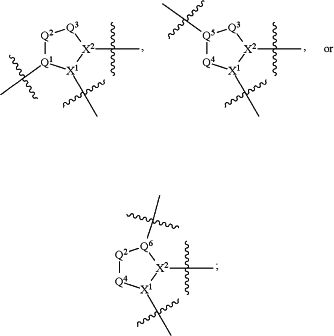 X1 and X2 are independently N, CH, or CZ, wherein X1 is directly bound to L2 and X2 is directly bound to L1;
Q1 is N or C(R1), wherein Q1 is directly bound to X9;
Q2 is C(R2R2′);
Q3 is C(R3R3);
Q4 is C(R1R1);
Q5 is C(R2) or N wherein Q5 is directly bound to X9;
Q6 is N or C(R3), wherein Q6 is directly bound to X9;
Z is F, Cl, NH2, CH3, CH2D, CHD2, or CD3;
R1, R1′, R2, R2′, R3, and R3′ are independently selected from hydrogen, R201, halogen, hydroxyl, nitro, cyano, amino, C1-C6alkyl, C2-C6alkenyl, C2-C6alkynyl, C1-C6alkoxy, C2-C6alkanoyl, C1-C6alkylthio-, hydroxyC1-C6alkyl-, aminoC1-C6alkyl-, -C0-C4alkylNR9R10, —C(O)OR9, —OC(O)R9, —NR9C(O)R10, —C(O)NR9R10, —OC(O)NR9R10, —NR9C(O)OR10, —OR′, —NR′R″, C1-C6haloalkyl, and C1-C6haloalkoxy;
or R1 and R2 are taken together to form a 3-membered carbocyclic ring, a 4- to 6-membered carbocyclic or aryl ring, or a 4- to 6-membered heterocyclic or heteroaryl ring containing 1 or 2 heteroatoms independently selected from N, O, and S;
or R2 and R3 are taken together to form a 3- to 6-membered carbocyclic or aryl ring or a 3- to 6-membered heterocyclic or heteroaryl ring;
R′ and R″ are independently selected from H, R201, alkyl, cycloalkyl, cycloalkylalkyl, heterocycle, heterocycloalkyl, aryl, arylalkyl, heteroaryl, and heteroarylalkyl;
A1 is
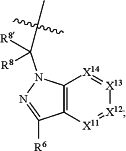 L1 is a bond,
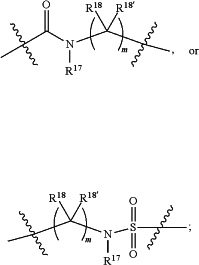 L2 is —C(O)—, —C(S)—, —P(O)OH—, —S(O)—, —S(O)2—, or —C(R52)2—;
L3 is
 X3, X4, X5, X6, X7, and X8 are each independently selected from alkyl, bond, —C(R52)2—, —C(R52)2C(R52)2—, —C(R52)2C(R52)2C(R52)2—, —C(O)—, —C(S)—, —P(O)OR9—, —S(O)—, —S(O)2—, —O—, —S—, R201 in a divalent state, alkenylene, alkynylene, heterocycle, heteroalkylene, heteroalkynylene, heteroalkenylene, arylalkyl, heterocycloalkyl, heteroarylalkyl, aryl, heteroaryl, cycloalkyl, and —NR9—;
X9 and X10 are independently selected from alkylene, —C(R52)2, —C(R52)2O—, —C(R52)2NR9—, —C(R52)2OC(O)—, —C(R52)2NR9C(O)—, —O—, —S—, —C(O)—, —C(S)—, —P(O)OR9—, —S(O)—, —S(O)2—, alkenylene, alkynylene, R201 in a divalent state, R32 in a divalent state, —NR9—, —CH2O—, —CH2N(H)—, —CH2OC(O)—, —CH2N(H)C(O)—, —CH2N(CH3)—, and —CH2N(CH3)C(O)—; or
X9-L3-X10 or X10-L3-X9 is
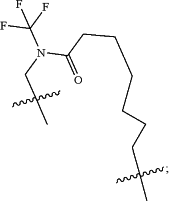 X11 is CR11;
X12 is CR12;
X13 is CR13;
X14 is CR14;
R6 are independently is selected from hydrogen, halogen, —CHO, —C(O)NH2, -C2-C6alkanoyl, —C(O)NH(CH3), —COON, —P(O)(OR9)2, —OC(O)R9, —C(O)OR9, nitro, hydroxyl, phenyl, 5- to 6-membered heteroaryl, cyano, amino, and C1-C6alkyl;
R8 and R8′ are independently selected from hydrogen, halogen, hydroxyl, C1-C6alkyl, -C0-C4alkyl(C3-C7cycloalkyl), C1-C6alkoxy, and (C1-C4alkylamino)C0-C2alkyl;
or R8 and R8′ are taken together to form an oxo group;
or R8 and R8′ are taken together to form a 3-membered carbocyclic ring;
R9 and R10 are independently selected at each occurrence from hydrogen, C1-C6alkyl, (C3-C7cycloalkyl)C0-C4alkyl, -C0-C4alkyl(C3-C7cycloalkyl), and —O-C0-C4alkyl(C3-C7cycloalkyl);
R11, R12, R13, and R14 are independently selected at each occurrence from hydrogen, R201, halogen, hydroxyl, nitro, cyano, —O(PO)(OR9)2, —(PO)(OR9)2, C1-C6alkyl, C2-C6alkenyl, C2-C6alkynyl, -C2-C6alkenyl-aryl, -C2-C6alkenyl-cycloalkyl, -C2-C6alkenyl-heterocycle, -C2-C6alkenyl-heteroaryl, C2-C6alkynyl, -C2-C6alkynyl-aryl, -C2-C6alkynyl-cycloalkyl, -C2-C6alkynyl(heterocycle), -C2-C6alkynyl-heteroaryl, C2-C6alkanoyl, C1-C6alkoxy, C1-C6thioalkyl, -C0-C4alkyl(mono- and di-alkylamino), -C0-C4alkyl(C3-C7cycloalkyl), -C0-C4alkoxy(C3-C7cycloalkyl), C1-C6haloalkyl, C1-C6haloalkoxy, amino, —COON, -C0-C4alkyl(C3-C7cycloalkyl), C2-C6alkenyloxy, —C(O)OR9, C0-C4alkylNR9R10, —C(O)NR9R10, —SO2R9, —SO2NR9R10, —OC(O)R9, —C(NR9)NR9R10, and R32, each of which other than hydrogen, halogen, hydroxyl, nitro, cyano, haloalkyl, and haloalkoxy is optionally substituted with one or more substituents independently selected from halogen, hydroxyl, nitro, cyano, amino, —COON, —CONH2, C1-C6haloalkyl, C1-C6haloalkoxy, phenyl, 4- to 7-membered heterocycle containing 1, 2, or 3 heteroatoms independently selected from N, O, and S, each of which phenyl or 4- to 7-membered heterocycle is optionally substituted with one or more substituents independently selected from halogen, hydroxyl, nitro, cyano, C1-C6alkyl, C2-C6alkenyl, C2-C6alkanoyl, C1-C6alkoxy, (mono- and di-alkylamino)C0-C4alkyl, C1-C6alkylester, -C0-C4alkyl(C3-C7cycloalkyl), C1-C6haloalkyl, and C1-C6haloalkoxy;
R17 is hydrogen, C1-C6alkyl, or -C0-C4alkyl(C3-C7cycloalkyl);
R18 and R18′ are independently selected from hydrogen, halogen, hydroxymethyl, and methyl;
R21 and R22 are independently selected from hydrogen, hydroxyl, cyano, amino, C1-C6alkyl, C1-C6haloalkyl, C1-C6alkoxy, (C3-C7cycloalkyl)C0-C4alkyl, (phenyl)C0-C4alkyl, -C1-C4alkylOC(O)OC1-C6alkyl, -C1-C4alkylOC(O)C1-C6alkyl, -C1-C4alkylC(O)OC1-C6alkyl, (4- to 7-membered heterocycloalkyl)C0-C4alkyl having 1, 2, or 3 heteroatoms independently selected from N, O, and S, and (5- or 6-membered unsaturated or aromatic heterocycle)C0-C4alkyl having 1, 2, or 3 heteroatoms independently selected from N, O, and S;
or R21 and R22 can be taken together to form a carbocyclic or heterocyclic ring;
R23 is independently selected from C1-C6alkyl, C1-C6haloalkyl, (aryl)C0-C4alkyl, (C3-C7cycloalkyl)C0-C4alkyl, (phenyl)C0-C4alkyl, (4- to 7-membered heterocycloalkyl)C0-C4alkyl having 1, 2, or 3 heteroatoms independently selected from N, O, and S, and (5- or 6-membered unsaturated or aromatic heterocycle)C0-C4alkyl having 1, 2, or 3 heteroatoms independently selected from N, O, and S;
R24 and R25 are taken together with the nitrogen to which they are attached to form a 4- to 7-membered monocyclic heterocycloalkyl group, or a 6- to 10-membered bicyclic heterocyclic group having fused, spiro, or bridged rings;
R32 is selected from hydrogen, aryl, heteroaryl, heterocycle,
 and
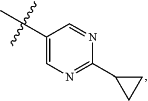 wherein the aryl, heteroaryl, and heterocycle can be optionally substituted with 1, 2, 3, or 4 substituents independently selected from halogen, hydroxyl, amino, cyano, —CHO, —COON, —CONH2, C1-C6alkyl, C2-C6alkenyl, C2-C6alkynyl, C1-C6alkoxy, C2-C6alkanoyl, C1-C6alkylester, (mono- and di-C1-C6alkylamino)C0-C2alkyl, C1-C6haloalkyl, hydroxyC1-C6alkyl, -C0-C6alkyl-heterocycle, -C0-C6alkyl-heteroaryl, C1-C6haloalkoxy, and R201;
B2 is a heteroaryl, heterocycle, or aryl group directly bound to both L1 and X10 at two independent positions;
wherein, each of which B2 is optionally substituted with one or more substituents independently selected from R33, R34, R35, R36, and R201;
R33 is independently selected from halogen, hydroxyl, —COON, cyano, C1-C6alkyl, C2-C6alkanoyl, C1-C6alkoxy, -C0-C4alkylNR9R10, —SO2R9, C1-C6haloalkyl, and C1-C6haloalkoxy;
R34 is independently selected from nitro, C2-C6alkenyl, C2-C6alkynyl, C1-C6thioalkyl, -JC3-C7cycloalkyl, —B(OH)2, -JC(O)NR9R23, -JOSO2OR21, —C(O)(CH2)1-4S(O)R21, —O(CH2)1-4S(O)NR21R22, -JOP(O)(OR21)(OR22), -JP(O)(OR21)(OR22), -JOP(O)(OR21R22), -JP(O)(OR21)R22, -JOP(O)R21R22, -JP(O)R21R22, -JSP(O)(OR21)(OR22), -JSP(O)(OR21)(R22), -JSP(O)(R21)(R22), -JNR9P(O)(NHR21)(NHR22), -JNR9P(O)(OR21)(NHR22), -JNR9P(O)(OR21)(OR22), -JC(S)R21, -JNR21SO2R22, -JNR9S(O)NR10R22, -JNR9SO2NR10R22, -JSO2NR9COR22, -JSO2NR9CONR21R22, -JNR21SO2R22, -JC(O)NR21S02R22, -JC(NH2)═NR22, -JCH(NH2)NR9S(O)2R22, -JOC(O)NR21R22, -JNR21C(O)OR22, -JNR21OC(O)R22, —(CH2)1-4C(O)NR21R22, -JC(O)NR24R25, -JNR9C(O)R21, -JC(O)R21, -JNR9C(O)NR10R22, —CCR21, —(CH2)1-4OC(O)R21, and -JC(O)OR23; each of which R34 is optionally substituted with one or more substituents independently selected from halogen, hydroxyl, nitro, cyano, amino, oxo, —B(OH)2, —Si(CH3)3, —COON, —CONH2, —P(O)(OH)2, C1-C6alkyl, -C0-C4alkyl(C3-C7cycloalkyl), C1-C6alkoxy, -C0-C2alkyl(mono- and di-C1-C4alkylamino), C1-C6alkylester, C1-C4alkylamino, C1-C4hydroxylalkyl, C1-C6haloalkyl, and C1-C6haloalkoxy;
R35 is independently selected from naphthyl, naphthyloxy, indanyl, (4- to 7-membered heterocycloalkyl)C0-C4alkyl containing 1 or 2 heteroatoms selected from N, O, and S, and bicyclic heterocycle containing 1, 2, or 3 heteroatoms independently selected from N, O, and S, and containing 4- to 7-ring atoms in each ring; each of which R35 is optionally substituted with one or more substituents independently selected from halogen, hydroxyl, nitro, cyano, C1-C6alkyl, C2-C6alkenyl, C2-C6alkanoyl, C1-C6alkoxy, (mono- and di-alkylamino)C0-C4alkyl, C1-C6alkylester, -C0-C4alkyl(C3-C7cycloalkyl), —SO2R9, C1-C6haloalkyl, and C1-C6haloalkoxy;
R36 is independently selected from tetrazolyl, (phenyl)C0-C2alkyl, (phenyl)C1-C6alkoxy, phenoxy, and heteroaryl containing 1, 2, or 3 heteroatoms independently selected from N, O, B, and S, each of which R36 is optionally substituted with one or more substituents independently selected from halogen, hydroxyl, nitro, cyano, C1-C6alkyl, C2-C6alkenyl, C2-C6alkanoyl, C1-C6alkoxy, (mono- and di-alkylamino)C0-C4alkyl, C1-C6alkylester, -C0-C6alkyl(C3-C7cycloalkyl), —SO2R9, —OSi(CH3)2C(CH3)3, —Si(CH3)2C(CH3)3, C1-C6haloalkyl, and C1-C6haloalkoxy;
R52 is independently selected from halo, hydrogen, or C1-C6alkyl, amino, hydroxyl, aminoalkyl, alkenyl, alkynyl, C2-C6alkenyl(aryl), C2-C6alkenyl(cycloalkyl), C2-C6alkenyl(heterocycle), C2-C6alkenyl(heteroaryl), alkynyl, C2-C6alkynyl(aryl), C2-C6alkynyl(cycloalkyl), C2-C6alkynyl(heterocycle), C2-C6alkynyl(heteroaryl), alkanoyl, C1-C6alkoxy, C1-C6thioalkyl, -C0-C4alkyl(mono- and di-alkylamino), -C0-C4alkyl(C3-C7cycloalkyl), -C0-C4alkoxy(C3-C7cycloalkyl), haloalkyl, haloalkoxy, —COON, -C0-C4alkyl(C3-C7cycloalkyl), C2-C6alkenyloxy, —C(O)OR9, -C0-C4alkylNR9R10, —C(O)NR9R10, —SO2R9, —SO2NR9R10, —OC(O)R9, R201, and N(R9)C(O)R10;
or two R52 groups can be taken together to form an oxo or alkene group;
or two R52 groups can be taken together to form a 3- to 6-membered carbocyclic spiro ring or a 3- to 6-membered heterocyclic spiro ring containing 1 or 2 heteroatoms independently selected from N, O, or S;
R201 is selected from aminoalkyl-, alkylaminoalkyl-, heterocycloalkyl-, hydroxyalkyl, -alkyl—O-alkyl, -alkyl—S-alkyl, -alkyl—N(alkyl)-alkyl, -alkyl—NH-alkyl, -aliphatic—O-aliphatic, -aliphatic—S-aliphatic, -aliphatic—N(aliphatic)-aliphatic, -aliphatic—NH-aliphatic, -aliphatic—O-heterocycle, -aliphatic—S-heterocycle, -aliphatic—N(aliphatic)-heterocycle, -aliphatic—NH-heterocycle, -alkyl—NHC(O)haloalkyl, -alkyl—NR9C(O)haloalkyl, -alkyl—C(O)NHhaloalkyl, -alkyl—C(O)NR9haloalkyl, -alkyl—NHC(O)haloalkyl, -alkyl—NR9C(O)aliphatic, -alkyl—C(O)NHaliphatic, -alkyl—NR9C(O)aliphatic, -alkyl—NHC(O)aliphatic, alkyl—O-haloalkyl, alkyl-heteroaryl, heteroaryl, heterocycle, alkyl-heterocycle, and —N(aliphatic)2;
J is independently selected from a covalent bond, C1-C4alkylene, —OC1-C4alkylene, C2-C4alkenylene, and C2-C4alkynylene; and
m is 0, 1, 2, or 3.
|